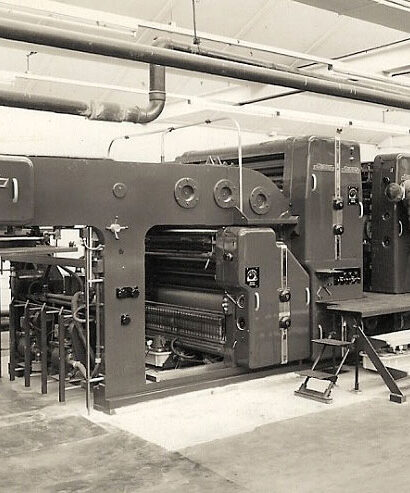Fortune reported that 94% of Fortune 1000 companies had supply chain disruptions due to COVID-19, and 75% reported negative impacts on their businesses. And the print industry is no exception which has seen significant shortages of raw materials like paper and ink. Additionally, current disruptions have also resulted in increased costs of substrates as well as consumables.
Member countries of the World Print & Communication Forum (WPCF), have warned that the current paper shortages will have severe repercussions in the supply of print products for all economic markets and are endangering the sector’s rebound after the coronavirus pandemic.
Paper shortages along with global awareness and demand for sustainable manufacturing have made the print industry look for new innovations that would enable them to strike the balance between the two.
As Cecilia Alcoreza, manager of forest sector transformation for the World Wildlife Fund conservation group observed, “Every single sheet of paper that we use has a global environmental impact.”
“And even at the end of its life cycle. If paper products end up in landfill, they produce a lot of CO2 emissions. Paper has a very big carbon footprint. And we’re still using a lot of paper. This is still one of the largest industries in the world.”
Aren’t we supposed to need less paper?
This will sound counterintuitive in the digital age.
“Amazingly, demand for paper is still going up,” said Julian Allwood, a professor of engineering and the environment at the University of Cambridge. In an interview with the BBC, Allwood stated: “After 50 years of talking about the paperless office, we haven’t got there yet. We could change that by changing the amount of paper and packaging we’re all using.”
Ironically, despite the ’70s being mostly non-digital, we used far less paper then, since making copies required going through the laborious and now antiquated process of mimeographing. . Then came the 1980s, when we discovered how simple it was to place a piece of paper on a glass plate, press a button, and make a copy. Not long after, fax machines began to appear in offices across the country, churning out their gleaming thermal paper. Paper consumption skyrocketed as a result.
Printing is still simple and inexpensive, at least in terms of the costs involved, so few businesses have any financial incentive to cut back. However, it is not so cheap when it comes to the environment.
Now, a new device, developed by an Israel-based company, could help us do that. An Israeli company called Reep Technologies has developed a technology that strips the ink from a sheet of paper so that it can be reused.
A machine that deletes the printed words
“It removes, completely evaporates, ink from a sheet of paper without any damage,” said Barak Yekutiely, co-founder of Reep Technologies.
It’s done with a powerful laser and a special paper coating that stops ink soaking into the page and once the laser has burned off the ink, the text simply disappears without a trace.
They basically evaporate the ink and what’s left is just pigments of the ink they collect, which can be recycled back into new printer inks.
“This means the same sheet of paper can be used and reused again and again,” added Barak Yekutiely. “We can reprint up to 10 times. Eventually, we might be able to reprint 20, 50 or even 100 times.”
Given the huge savings of paper, Barak said their so-called circular printing will be much cheaper than the conventional process. It can help save the planet too.
“Reep can achieve a 90% or more reduction in CO2 and the consumption of resources, such as biomass, water, chemicals, energy and, of course, trees,” he said.
The Reep method totally removes all of the ink from the paper using cutting-edge laser technology. The basis of Reep’s solution is laser de-printing in conjunction with cutting-edge materials that permit paper re-use. It is the first de-printing technique to pass Ingede’s renowned deinking test with a perfect score.
Circular printing
Reep’s innovative technique for reprinting, thus allowing reusing the paper for printing is a great stride towards enabling organizations to adopt circular printing. It allows them to do away with the linear printing procedures that are harmful to the environment and adopting sustainable practices that involve using fewer resources and producing less waste.
Reep offers the world’s first practical, industrial-strength system for circular printing. Reep’s solution sets a new standard in sustainability for office printing, while also meeting the economic and operational requirements for leading enterprises and organizations:
The firm also claimed it was the first de-printing technology to receive a 100% score on deinking association Ingede’s industry-standard deinking test.
Not the first time
It’s not the first time that “de-printing” has been contemplated or attempted.
A decade ago, scientists at the University of Cambridge came up with the idea of vaporizing toner using short pulses of a green laser to “unprint” paper.
Printer manufacturer Toshiba also developed erasable toner using a heating method and its own proprietary toner. It brought the product to market in the shape of its Eco MFP office printer featuring normal black and erasable blue toner, allowing paper to be erased and reused.
In a manner somewhat similar to Toshiba’s solution, the Xerox technology can be printed and then erased – by applying another wavelength of UV light – over and over again, allowing for the paper to be reused repeatedly. However, the printed material the Xerox technology produces isn’t for the long term; thus far, it can last only about a day.
The way forward
The challenge would be keeping the same sheet of paper in good condition after it’s been reprinted and handled 10 times. But the Yekutielys, who are planning to launch a circular printing service for businesses and governments next year, expressed confidence that customers will adapt to the need to return the paper for reprinting in reasonable shape. They say deprinting represents a historic turning point.
“This is a breakthrough for the print and paper industries in that it creates a sustainable usage model for the first time since the invention of paper and printing,” Barak said.
While Reep is presently proposing a printing service, it may eventually enter the technology licensing market and work toward the creation of a printer and deprinter that is compact enough to be placed next to any home or office computer.
That would really be a breakthrough — and a sign that the paper industry has turned the page on pollution.
“It is not yet made clear by the company as to which printing method deprinter would potentially be compatible with, but it seems as if office printers and copy machines will be the first focus. The company is looking for sustainable organizations to join its piloting program in order to help give the product a purpose and reach its potential sooner.
Machine Dalal platform is preferred by buyers and sellers from the global print industry to get directly connected with each other and trade their machinery.
Visit the Machine Dalal website or simply download our app onto your Android or iOS smartphone.




